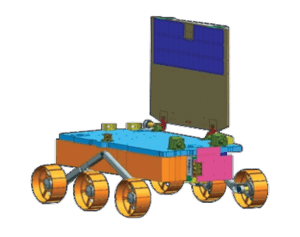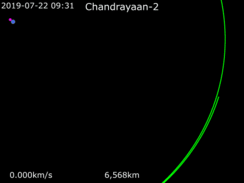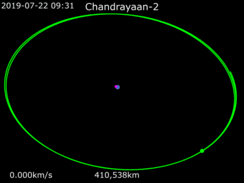Chandrayaan-2 facts for kids

Chandrayaan-2 composite
|
|
| Mission type | Lunar orbiter, lander, rover |
|---|---|
| Operator | Indian Space Research Organisation (ISRO) |
| Mission duration |
|
| Spacecraft properties | |
| Manufacturer | Indian Space Research Organisation (ISRO) |
| Launch mass | Combined (wet): 3,850 kg (8,490 lb) Combined (dry): 1,308 kg (2,884 lb) Orbiter (wet): 2,379 kg (5,245 lb) Orbiter (dry): 682 kg (1,504 lb) Vikram lander (wet): 1,471 kg (3,243 lb) Vikram lander (dry): 626 kg (1,380 lb) Pragyan rover: 27 kg (60 lb) |
| Power | Orbiter: 1 kW (1.3 hp)
Vikram lander: 650 W Pragyan rover: 50 W |
| Start of mission | |
| Launch date | 22 July 2019, 14:43:12 IST (09:13:12 UTC) |
| Rocket | GSLV Mark III M1 |
| Launch site | Satish Dhawan Space Centre Second Launch Pad |
| Contractor | Indian Space Research Organisation (ISRO) |
| Moon orbiter | |
| Orbital insertion | 20 August 2019, 09:02 IST (03:32 UTC) |
| Orbit parameters | |
| Pericynthion | 100 km (62 mi) |
| Apocynthion | 100 km (62 mi) |
| Moon lander | |
| Spacecraft component | Rover |
| Landing date | 7 September 2019, 01:53 IST (failure) (6 September 2019, 20:23 UTC) |
| Landing site | Lunar south pole (intended) |
Chandrayaan-2 is a special mission to the Moon from India. It was built by the Indian Space Research Organisation (ISRO). This mission included three main parts: an orbiter that goes around the Moon, a lander called Vikram, and a rover called Pragyan.
The main goal of Chandrayaan-2 was to study the Moon's surface. Scientists wanted to find out what the Moon is made of and where water might be found. The mission also aimed to show that India could successfully land a spacecraft on the Moon.
The spacecraft launched on 22 July 2019, from the Satish Dhawan Space Centre in India. It reached the Moon's orbit on 20 August 2019. The Vikram lander and Pragyan rover were supposed to land near the Moon's south pole on 6 September 2019. If the landing had been successful, India would have been the fourth country to achieve a soft landing on the Moon.
However, the Vikram lander did not land softly. It lost contact with Earth and crashed on the Moon. Scientists later found that a computer problem caused the crash. Even though the lander failed, the orbiter part of Chandrayaan-2 is still working. It continues to orbit the Moon and send back important scientific information.
Contents
History of Chandrayaan-2
The idea for Chandrayaan-2 started in 2007. India's ISRO and Russia's Roscosmos space agencies agreed to work together. ISRO would build the orbiter and rover, and Russia would provide the lander.
In 2008, the Indian government approved the mission. The spacecraft's design was ready by 2009. However, the mission faced delays. Russia could not build the lander on time. This was partly because of problems with another Russian mission to Mars.
So, in 2012, India decided to build the entire mission by itself. This meant ISRO would design and build the lander too. The launch was first planned for 2018, but it was delayed a few times for more tests.
The final launch date was set for 15 July 2019. But just before launch, a technical problem stopped it. The launch was then rescheduled and successfully happened on 22 July 2019.
On 6 September 2019, the Vikram lander began its descent to the Moon. But it went off course and lost communication with Earth. It crashed on the Moon's surface. A special committee found that a software issue caused the crash.
Mission Goals
The main goals for the Vikram lander were to:
- Show that India could land a spacecraft softly on the Moon.
- Operate a robotic rover on the Moon's surface.
The scientific goals for the orbiter are to:
- Study the Moon's surface, including its mountains, valleys, and what it's made of.
- Look for signs of water ice and other elements.
- Study the Moon's thin atmosphere, called the exosphere.
- Create 3D maps of the Moon's surface.
- Learn about water ice near the Moon's south pole.
Spacecraft Design
The name Chandrayaan means "mooncraft" in Sanskrit and Hindi. The Chandrayaan-2 mission was launched using India's powerful Geosynchronous Satellite Launch Vehicle Mark III (GSLV Mk III) rocket. The total weight of the spacecraft was about 3,850 kilograms (8,490 pounds).
The mission cost about 9.78 billion Indian Rupees (around 141 million US dollars). This included money for building the spacecraft and for the launch.
The Orbiter
The Chandrayaan-2 orbiter is like a satellite that flies around the Moon. It circles the Moon in a polar orbit, about 100 kilometers (62 miles) above the surface. It carries eight scientific tools to study the Moon. Two of these tools are improved versions of those used on India's first Moon mission, Chandrayaan-1.
The orbiter weighs about 2,379 kilograms (5,245 pounds) when it launched. It was designed to work for about one year, but it has enough fuel to last for about 7.5 years.
- Size: 3.2 × 5.8 × 2.2 meters
- Weight (at launch): 2,379 kg (5,245 lb)
- Power: 1000 watts
- Mission time: About 7.5 years
The Vikram Lander
The Vikram lander was named after Vikram Sarabhai, who is known as the founder of India's space program. The lander was designed to separate from the orbiter and slowly descend to the Moon's surface.
After landing, it would have deployed the Pragyan rover. The lander was supposed to perform scientific tasks for about 14 Earth days (one lunar day). However, as mentioned, Vikram crashed during its landing attempt. The lander and rover together weighed about 1,471 kilograms (3,243 pounds).
Vikram had special engines to control its descent. It also had cameras and sensors to help it find a safe landing spot. Engineers even created small craters on Earth to test the lander's sensors.
- Size: 2.54 × 2 × 1.2 meters
- Weight (at launch): 1,471 kg (3,243 lb)
- Power: 650 watts
- Planned mission time: Up to 14 days
The Pragyan Rover
The rover was named Pragyan, which means "Wisdom" in Sanskrit. It weighed about 27 kilograms (60 pounds) and was powered by solar energy.
Pragyan had six wheels and was designed to move slowly across the Moon's surface. It could travel up to 500 meters (1,640 feet) and perform scientific tests right there. It would then send the information back to the Vikram lander, which would relay it to Earth.
The rover had special cameras to create 3D maps of the terrain. This helped the control team on Earth plan its path. Its wheels also had the ISRO logo and India's national emblem, so it would leave special tracks on the Moon!
- Size: 0.9 × 0.75 × 0.85 meters
- Power: 50 watts
- Travel speed: 1 centimeter per second
- Planned mission time: Up to 14 days
Science Tools
Chandrayaan-2 carried many scientific tools to study the Moon. The orbiter had eight tools, the lander had four, and the rover had two.
Orbiter Tools
The tools on the orbiter were designed to:
- CLASS (Soft X-ray Spectrometer): Figure out what elements are on the Moon's surface using X-rays.
- XSM (Solar X-ray Monitor): Map the Moon's surface.
- DFSAR (Synthetic Aperture Radar): Look a few meters deep into the Moon's surface to find water ice.
- IIRS (Imaging IR Spectrometer): Map minerals and water molecules on the Moon.
- ChACE-2 (Atmospheric Compositional Explorer 2): Study the Moon's very thin atmosphere.
- TMC-2 (Terrain Mapping Camera-2): Create 3D maps of the Moon's surface for geology studies.
- RAMBHA-DFRS (Radio Science experiment): Study the electron density in the Moon's atmosphere.
- OHRC (Orbiter High Resolution Camera): Take very detailed pictures of the Moon's surface, including the landing site. It had the best resolution of any lunar orbiter camera at the time.
Vikram Lander Tools
The tools on the Vikram lander were:
- ILSA (Instrument for Lunar Seismic Activity): Measure "Moon-quakes" near the landing site.
- ChaSTE (Chandra's Surface Thermo-physical Experiment): Measure how hot or cold the Moon's surface is.
- RAMBHA-LP (Langmuir Probe): Measure the density of plasma (charged particles) on the Moon's surface.
- LRA (Laser Retroreflector Array): A small mirror from NASA to help measure distances between satellites and the Moon's surface very precisely.
Pragyan Rover Tools
The Pragyan rover carried two tools to find out what elements were near its landing spot:
- LIBS (Laser induced Breakdown Spectroscope): Uses a laser to identify elements.
- APXS (Alpha Particle Induced X-ray Spectroscope): Uses X-rays to identify elements.
Mission Journey
Launch and Earth Orbit
Chandrayaan-2 was supposed to launch on 15 July 2019. But a technical problem stopped the countdown less than an hour before launch. The problem was fixed, and the rocket successfully launched on 22 July 2019.
After launch, the spacecraft was put into an orbit around Earth. Over the next 22 days, it slowly raised its orbit using its own engines. This helped it gain enough speed to travel to the Moon.
Journey to the Moon
On 13 August 2019, Chandrayaan-2 left Earth's orbit and began its journey to the Moon. After 29 days from its launch, the spacecraft entered the Moon's orbit on 20 August 2019.
The spacecraft then performed several maneuvers to get into a circular orbit about 100 kilometers (62 miles) above the Moon's poles. On 2 September 2019, the Vikram lander separated from the orbiter.
The Landing Attempt
The Vikram lander began its descent to the Moon on 6 September 2019. It was supposed to land softly near the Moon's south pole. The landing was controlled by the lander's computers, with no direct control from Earth.
The first part of the descent went well. But when the lander was about 2.1 kilometers (1.3 miles) above the surface, its path changed. It lost communication with Earth just before it was supposed to touch down.
Scientists later confirmed that Vikram had a "hard landing," meaning it crashed. A committee found that a software problem caused the crash. The lander hit the Moon's surface at a speed of about 50 meters per second (112 miles per hour), which was too fast for a soft landing.
The crash site was later found by a volunteer from India, using images from NASA's Lunar Reconnaissance Orbiter. The spacecraft broke into many pieces upon impact.
Even though the lander failed, the orbiter part of Chandrayaan-2 is still working well. It continues to orbit the Moon and collect valuable scientific data. It is expected to work for about 7.5 years.
After the Landing Attempt
After the Vikram lander crashed, many people showed support for ISRO. It was a sad moment, but people recognized the hard work of the scientists.
ISRO learned important lessons from the landing attempt. These lessons will help them with future missions to the Moon.
Scientists Involved
Many talented scientists and engineers worked on Chandrayaan-2. Some key people included:
- Ritu Karidhal – Mission Director
- Muthayya Vanitha – Project Director
- K. Kalpana – Associate Project Director
- G. Narayanan – Associate Project Director
- Chandrakanta Kumar – Deputy Project Director (Radio systems)
- Amitabh Singh – Deputy Project Director (Optical Payload Data Processing)
Chandrayaan-3
In 2019, ISRO announced plans for a new mission called Chandrayaan-3. This mission will be another attempt to land a spacecraft on the Moon. It is planned to launch in 2021.
Chandrayaan-3 will include a lander and a rover, but not a new orbiter. It will use the Chandrayaan-2 orbiter to communicate with Earth. This new mission aims to show that India can successfully land on the Moon. ISRO plans to have even more Moon missions in the future.
Images for kids
See also
 In Spanish: Chandrayaan-2 para niños
In Spanish: Chandrayaan-2 para niños



















